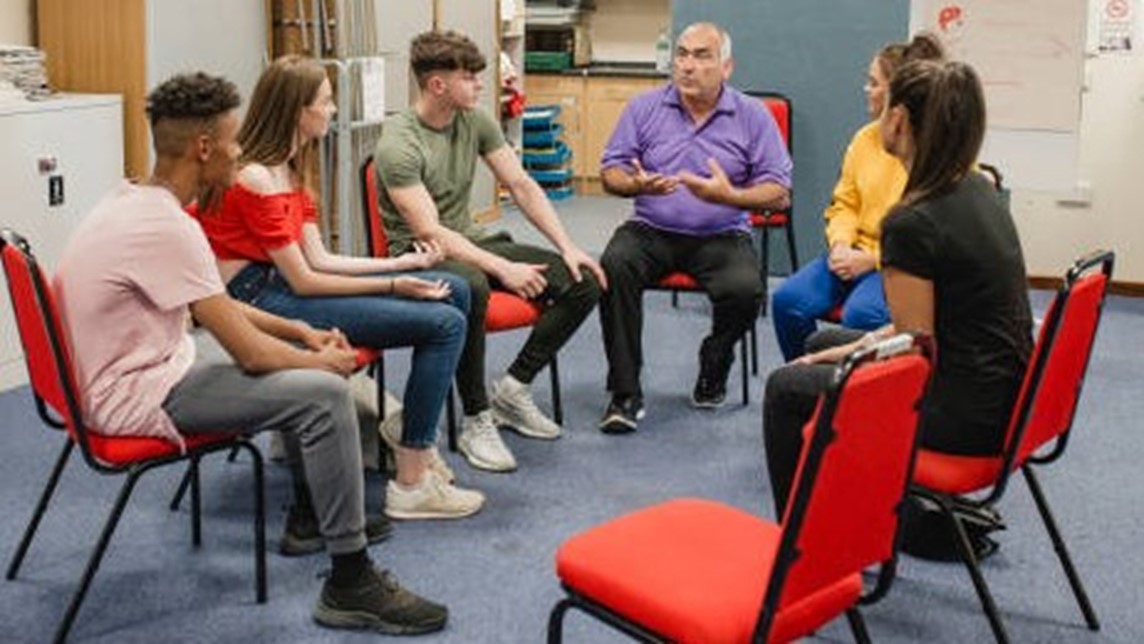By Jan Brennan
What do young people in your community think? How satisfied are they with your current youth programs and opportunities? How would youth in your community like to be civically engaged? To gain insights from youth, we must first design mechanisms for youth to share their ideas and feedback.
Surveys remain a popular and effective means to solicit youth input, but there are numerous creative ways to elevate youth voice in your community. When one method is used frequently or repeatedly to solicit input, fatigue often sets in and response rates drop, so it is helpful to use a variety of methods. This article outlines creative ideas for collecting youth input.
Nothing about us without us: Why youth input is critical
The opportunity for young people to express their views and share their ideas has benefits to both local communities and the youth themselves. Programs serving youth are often developed and implemented with little or no input from the people that use them, so it is not surprising when those programs fail to attract youth interest or effectively serve their needs. Research demonstrates that engaging the target population in the planning, content and delivery of programs increases the likelihood of success. Collecting input from youth allows communities to take an evidence-based approach to program and policy improvement.
For youth, soliciting their input demonstrates that their ideas and opinions matter. Young people appreciate being included in decision-making and having an influence, particularly in programs and policies that directly impact them. Allowing youth to inform community decisions and programs also lays the groundwork for other forms of youth engagement and participation.
Youth input can be particularly valuable to communities. Youth see problems from a unique perspective. They are often effective in identifying underlying issues and causes. And young people are more likely to challenge traditional thinking and solutions and to offer new and innovative ideas.
COLLECTING INPUT FROM YOUTH
In some cases, feedback is sought from all students or young people who participate in a program or are impacted by a policy being assessed. In other cases, the request for feedback is issued broadly and youth can choose whether to participate.
Surveys and Questionnaires
Surveys are relatively easy and low-cost to develop, administer and analyze. Surveys can be administered on paper, online, via phone or using text. They also allow for longer and more detailed information to be shared by youth. Typically, key national surveys such as the Youth Risk Behavior Survey and Developmental Assets Survey are administered in school settings.
Generally, young people have adequate reading skills to complete simple surveys or questionnaires beginning at a third-grade reading level. Surveys can also be read aloud and verbal responses recorded for young children. Avoid administering surveys or questionnaires on Mondays, Fridays or adjacent to holidays. It is also recommended that surveys not be administered in the the final weeks of the year when there may be more disruptions and absences.
A survey does not need to be extensive. One more innovative approach to surveys is to distribute paper or virtual index cards or post cards with a few simple prompts to complete.
Keep in mind that youth surveys are subject to the challenges of any self-reporting – even when confidential, those completing surveys are not always accurate or honest. Studies of youth survey responses suggest that 15-20 percent of teens may be “mischievous responders”1 who skew results with false or exaggerated answers. Help the youth understand the value of their honest and accurate input. You may also want to explore strategies for identifying and eliminating mischievous responses.
Interviews, Focus Groups and Listening Sessions
Interviews can be the source of valuable qualitative information. Interviews, focus groups or listening sessions can be the primary method of collecting feedback from youth, or can supplement a survey or questionnaire, providing additional insights. Ensure that you are conducting interviews with a representative group of the larger youth cohort.
As with any effort to collect youth input, trust and confidentiality are critical. The facilitator must be skilled in working with youth. A literature review of the research on youth focus groups notes that, “there are specific challenges to interviewing children. They can be inattentive or slow in their responses, they may lose interest, or they may withdraw from an adult who is too dominant.”2
Youth do not process questions in the same way and time as adults. Ask short, simple questions with language appropriate to the age of the youth. Ensure that questions can’t be answered with a simple “yes” or “no.” Ensure questions don’t convey a sense of judgement or make the youth feel defensive, being sensitive to “Why” and “How could you…” questions. Follow up with clarifying questions to drive better understanding of the youth input or seek additional detail.
 Common components to interviews and focus groups include a welcome and introduction, explanation of the purpose and how the youth input will be used, establishing ground rules to guide the conversation, prompting the discussion with a series of questions, and encouraging the participation of all the youth attending. Interviews and focus groups typically conclude with a thanks and explanation about how the results will be shared with participants.
Common components to interviews and focus groups include a welcome and introduction, explanation of the purpose and how the youth input will be used, establishing ground rules to guide the conversation, prompting the discussion with a series of questions, and encouraging the participation of all the youth attending. Interviews and focus groups typically conclude with a thanks and explanation about how the results will be shared with participants.
One more innovative approach to focus groups includes having the group conduct a “gallery walk.” Arrange different prompts, photos, quotes or ideas throughout a space and have focus groups walk around or rotate between the prompts. Each group reacts and discusses the prompt as they come to it.
Listening sessions are like focus groups, but there is less facilitation and structure. Youth are asked to discuss or answer questions about an issue or topic and the conversation is allowed to develop organically. It is difficult to facilitate a focus group with more than a dozen participations, so a listening session is a good choice when you have a larger group.
Cell Phone and Text
Communities are increasingly turning to cell phones and text messaging to survey and collect responses from youth. About 97 percent of youth identify text message as their preferred means of communication. Text message surveys also allow for quick response time and data collection. Finally, text messaging has proven a particularly effective method to reach youth that are not in educational settings. Text survey response rates are similar to those conducted on paper and offer an easy, low-cost option. Text surveys can share a link to an online survey or can ask youth to respond by text to one or more questions.
It is important to be aware of technical issues with text survey administration, including youth who don’t have a mobile phone and youth frequently reporting lost or damaged phones. In general, older, female and Latinx teens have the highest response rates to text surveys, so consider the demographic group you are trying to reach. Higher response rates are generated when using text questions that allow youth to state their preferences or quizzes that have a game quality and allow youth to demonstrate their knowledge.
Portfolios and Journaling
When soliciting input on a project or experience that extends over a summer, semester or year, consider having the subjects develop a portfolio or keep a journal that records their impressions over time. At the end of each session or at regular intervals during the program, provide time for them to capture their experience in writing or drawings. Journals need not all be written. Challenge them to create a photo journal that documents their experiences or captures successes and barriers for youth in their communities.
Group Presentations
To get feedback from a larger group of youth, divide them into teams and ask each team to prepare a response to a different question or prompt. Each group then presents to the full group. Allow the youth to be as creative as possible, sharing in the form of a poster, skit, rap or storytelling.
Mapping
See your community through the eyes of youth. Mapping engages youth in documenting community-based activities, resources or needs. The participants may draw maps from their existing knowledge, build maps based on community data that is provided, or mapping can be part of a larger youth engagement effort in which they inventory, canvass or conduct research to inform their maps.
The Maryvale neighborhood in Phoenix Arizona has an ongoing Map My Maryville Project focused on improving health outcomes for youth. The St. Louis Map Room project demonstrates a temporary project in which young people mapped their schools and travel routes, reflecting areas where they felt safe and areas where they felt it wasn’t safe.
Drawings or Collages
Ask participants to create a cartoon, drawing or collage in response to a question. For example, youth program participants might be asked to draw a picture in response to the question “What is the most important thing you’ve learned through this program?” or “What is your vision for youth engagement in our community?” It is important to provide an opportunity for the youth to explain what the drawing or images mean to them and to capture that as part of understanding the feedback.
Selfie Station
Youth have certainly mastered the selfie, so capitalize on this by providing a selfie station at your next youth event or design a campaign asking for selfie responses online or through social media. Create a sign or placard with a prompt that includes space for the young people to fill in their response. A selfie sign might range from “What I like best about this program is…” to “I hear about youth events in my community from…” or “I don’t smoke because…” with youth filling in their response and posting a selfie of themselves with the completed sign or placard.
Voting and Ratings
Collecting input from youth does not need to be high tech. A very simple method for collecting input is to ask them to vote for their preference among several options. They might be shown options on posters and signify their preference with a sticky dot or might drop a token in the jar placed in front of their preference. Double your feedback by coding the tokens. For example, you might assign tokens of different colors based on age. You’ll then be able to see, not only how the total group of youth responded, but to isolate the responses by age to see if younger youth and older youth may have different experiences or feedback.
 A bullseye, meter or other scale allows youth to rate the program or level of their experience. Another idea is to provide a series of cards and ask youth to order the cards based on their feedback. Cards might list various services offered to youth, with the youth asked to order the cards based on how valuable they find that service. Another fun idea is to get the youth moving to show their opinions. Designate a statement for each of the four corners of the room and have youth move to the corner that matches their response. Provide a chance for them to explain the reasons for their choice.
A bullseye, meter or other scale allows youth to rate the program or level of their experience. Another idea is to provide a series of cards and ask youth to order the cards based on their feedback. Cards might list various services offered to youth, with the youth asked to order the cards based on how valuable they find that service. Another fun idea is to get the youth moving to show their opinions. Designate a statement for each of the four corners of the room and have youth move to the corner that matches their response. Provide a chance for them to explain the reasons for their choice.
Feedback Wall
Collecting youth input can be as simple as providing a Feedback Wall with sticky notes and pens. Write one or more prompts on the wall and allow youth to post their reactions or ideas.
Ongoing Youth Input
The previous suggestions focus on soliciting youth input at one point in time on a particular project or issue. Communities can also collect youth input on an ongoing basis. Provide a website form, email, phone or text number where youth can leave input on their own. Like a youth crisis or threat reporting line, youth can access the youth feedback line to share confidential input. Establish local youth input hashtags to capture regular social media feedback. Pose a question on community social media and ask youth to comment. Offer a poll on social media to which youth can respond. Ask youth to post a comment or suggestion using a designated hashtag.
CONSIDERATIONS
 This article does not address the process of planning your survey, questionnaire or feedback campaign. Including the right number and type of questions, as well as designing questions that are easily understood and extract the information you need, are critical to success. It is important that youth are included in the planning, development and testing of the input campaign, and that they play an active role in the interpretation, dissemination and use of the data collected. When you will conduct interviews, focus groups or discussions, ensure that facilitators understand the techniques most effective with youth.
This article does not address the process of planning your survey, questionnaire or feedback campaign. Including the right number and type of questions, as well as designing questions that are easily understood and extract the information you need, are critical to success. It is important that youth are included in the planning, development and testing of the input campaign, and that they play an active role in the interpretation, dissemination and use of the data collected. When you will conduct interviews, focus groups or discussions, ensure that facilitators understand the techniques most effective with youth.
When and Where
Collecting input from youth will be easiest where youth are already gathering, so plan your survey or feedback process during a session of the program or class or use large community events that already attract youth.
Authorization and Parental Permission
You may need to secure authorization to collect input within a school, program or youth setting. For example, the school board may need to approve surveys conducted in the classroom. You will also need parental permission for those under 16 or 18 to participate, depending on state rules. Parental permission can be active, meaning that the parent provides a signature approving the participation of their child, or passive, which means that all students will participate in the survey unless the parent explicitly denies permission or opts-out. Active parental permission will require time and resources and can reduce participation by as much as 50 percent. Securing active parental permissions will likely necessitate distributing the permission form multiple times and following up by phone and email.
Administration
For consistency, youth should all take the survey or provide feedback under similar circumstances, including date, time and location of the input. Develop a standard script and instructions so that the survey will be administered in the same way to all participating youth. Be sure that appropriate codes or tags are created and included on surveys to track the source of the feedback.
Youth are generally comfortable completing surveys and questionnaires online, but completion rates tend to be lower than when completed in hard copy. Ensure that surveys are administered by teachers, coaches, administrative staff or external volunteers that have good rapport with students. Conveying a sense of trust and confidentiality will ensure students feel comfortable providing honest feedback.
If completing the feedback will require significant time, offer water or snacks. Some small token, such as a sticker, can serve as a thanks, or incentivize participation by entering participants into a prize drawing. Translate the survey as needed to reach your target youth audience and ensure that participation is open to youth that are differently abled.
Student Privacy
Student privacy is important from a legal perspective, but also critical to ensure youth provide honest and frank input. Start with a policy that outlines how you will use and share youth feedback or survey data. Clarify what information may be subject to open record requests and ensure that information and data does not identify individual youth. Assign random codes to identify and track each separate group or individual youth that will be sharing feedback, providing a level of confidentiality. Keep data in a secure location and delete or destroy the individual response forms once the data has been extracted and entered. It is recommended that those administering and working with youth input data sign a confidentiality agreement if they are not already subject to such a restriction.
Equity and Representation
Don’t make the mistake of thinking that if you’ve asked for input from some youth, that input is representative of all youth in your community. Be sure to seek and include input from youth of different backgrounds, economic status, race, religion, ability and gender orientation and expression. As one U.S. Health and Human Services publication suggests: “Equitable engagement means that youth of all backgrounds and lived experiences, particularly those who are the most vulnerable, have opportunities to participate, be empowered, and have their voices heard along with other youth in decisions that affect their lives.”3
Where you will be collecting input from only a portion of youth involved with a program, ensure that you have a random and representative sample of the full youth cohort. You may choose to include more youth from historically marginalized groups to ensure that issues and perspectives specific to these populations are surfaced. When students will participate in interviews or focus groups, consider whether you will get the best information by having a mixed, representative group of youth or if it would be better to speak separately to sub-groups. For example, in evaluating a youth program where there may be meaningful gender differences, you may prefer to conduct one focus group with girls and another with boys.
Youth input is helpful, not just when it comes to youth programs, but also when it is related to programs and policies that impact the general public. We sometimes forget that youth represent almost a quarter of the U.S population, so they have a significant investment in a broad range of community issues. In addition, the young have more long-term interests on issues such as the environment and climate change. Finally, when youth have input, they are more likely to become advocates for the program or policy. They wield considerable influence, from peers to parents, and can have a strong impact on participation and success.
Resources
Many ideas are outlined in Creative Ways to Solicit Youth Input and Public Profit’s Creative Ways to Solicit Stakeholder Feedback. For Focus Groups, consult The Center for Community College Student Engagement’s Students Speak – A Focus Group Toolkit. Also check out the Listen Up! Youth Listening Session Toolkit.
There are many resources and toolkits for youth mapping, such as Community YouthMapping, Youth Community Mapping Toolkit Vancouver and Chicago Community Environmental Inventory.
Jan Brennan is a Senior Fellow for the National Civic League and serves as the Mountain West Director for the nonpartisan Campus Election Engagement Project, working with colleges and universities to increase the election and voting participation of their students. She is certified in youth program evaluation and as a Court Appointed Special Advocate for children within the justice system. In her work, she promotes applied civic learning and engagement from the classroom to the community, helping youth exercise their civic voice and power to promote a more inclusive and representative democracy.
1 Kamanetz. (2014). ‘Mischievous Responders’ Confound Research on Teens. National Public Radio. Retrieved from https://www.npr.org/sections/ed/2014/05/22/313166161/mischievous-responders-confound-research-on-teens
2 Adler, Salantera & Zumstein-Shaha. (2019). Focus Group Interviews in Child, Youth, and Parent Research: An integrative literature review. International Journal of Qualitative Methods. Retrieved from https://journals.sagepub.com/doi/full/10.1177/1609406919887274
3 U.S. Department of Health and Human Services, Office of Population Affairs, Listen Up! Youth Listening Session Toolkit. Washington, D.C.: U.S. Government Printing Office, September 2020. Retrieved from https://opa.hhs.gov/sites/default/files/2021-01/OPA_Youth_Toolkit_Final_508.pdf



